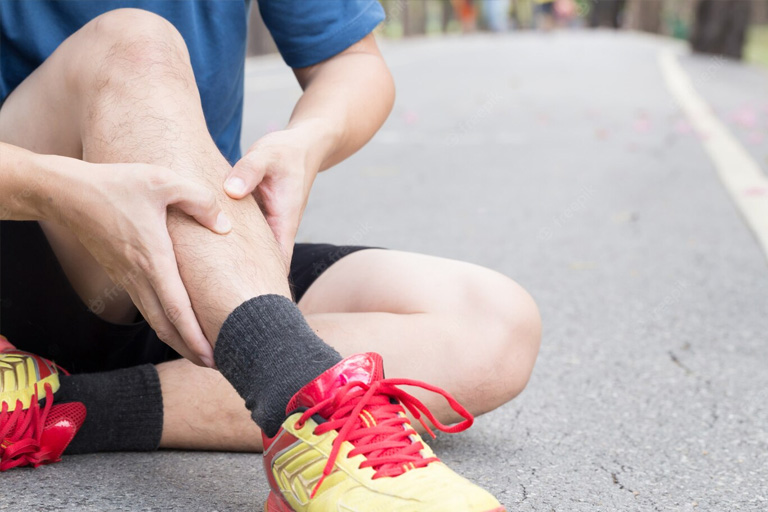
Put simply, shin splints are a result of overuse. They can be a problem for runners, dancers, gymnasts, tennis players and any active people whose exercise involves running, jumping and landing. (Hopkins Medicine)
What are Shin Splints?
The term “shin splints” refers to pain along the shin bone (tibia) — the large bone in the front of your lower leg. Shin splints are common in runners, dancers and military recruits.
Medically known as medial tibial stress syndrome, shin splints often occur in athletes who have recently intensified or changed their training routines. The increased activity overworks the muscles, tendons and bone tissue. (Mayo Clinic) Shin splints result from inflexible or tired calf muscles putting too much stress on tendons, which then become strained and torn. (Runners World)
What Do Shin Splints Feel Like?
Shin splints commonly feel like a nagging pain, in the front of your leg along the tibia. This pain is usually experienced during and after exercise, and when you press down on the area. (Runners World)
This pain gets worse with exercise and better with rest. If your shin splints are severe your legs may hurt even when you aren’t active. (Hopkins Medicine)

What Causes Shin Splints?
Shin splints most often happen after hard exercise, sports, or repetitive activity. This repetitive action can lead to inflammation of the muscles, tendons, and thin layer of tissue covering the shin bones, causing pain. They can develop when you increase your activity level or change your activity routine.
Running on hard surfaces is a common culprit. Repetitive high impact leg activities can damage the muscles, tendons, and bones of your lower legs. The connective muscle that holds muscle to bone can stretch, and tear. This causes inflammation and pain. Shoes that are worn out or don’t fit properly, can also increase your likelihood of getting shin splints. (Hopkins Medicine)
Shin Splints Prevention
Some simple tips to prevent shin splints include:
- Stretching your calves and hamstrings, as tight muscles in the leg can put you at risk for shin splints.
- Avoiding sudden increases in physical activity. Gradually increase activities that involve jumping, running and walking, rather than trying to suddenly ‘smash it’. This includes spreading out days between activities and/or doing alternate forms of exercise.
- Exercise on softer surfaces when possible, as exercising on hard surfaces (ie. footpaths) increases the amount of force that your bones and muscles have to absorb. This causes muscle fatigue and overuse, and ultimately, shin splints. Choose more “pliant” or soft surfaces (such as sprung wood floors, grass, dirt, sand, synthetic tracks and fields) to prevent your bones, muscles, tendons, and joints from having to absorb so much shock.
- Strengthen your foot and the arch of your foot.
Strengthen the arch muscles of your foot by using your toes to pull a towel on the floor closer to your foot. This may help the arch work more effectively to reduce or prevent shin splint pain. Use foot orthotics for high arches. - Strengthen your hip muscles.
Strengthen your hip muscles to help absorb more of the shock and pressure on the legs during exercise. - Make sure your shoes are right for you.
Ill-fitting shoes, or shoes that lack proper features can contribute to shin splints. - Stay at a healthy body weight.
Increased body weight, or being overweight,can lead to a higher risk of shin splints. - Have your running and jumping technique analysed and corrected by a physical therapist.
Incorrect running, jumping, and landing techniques can be a cause of shin splints. Your physical therapist can help you understand how to improve your exercise techniques to avoid shin splint pain.
Note: Stretching and strengthening the tibialis anterior muscle can lessen your chances of getting shin splints. This often overlooked muscle in the lower leg often needs more attention. When stretching or exercising the lower legs many people focus their efforts on the calves, but It’s important to include the tibialis anterior muscle stretching and exercising into your routine to avoid disparity between the front and back of your lower legs. Check out this wonderful range of exercises from Set for Set.
Shin Splints Treatment
Shin splints heal on their own with proper rest. If possible, a 2-week rest from the activity that caused the injury is recommended (Medical News Today).
You can help your shin splints heal by avoiding high impact activities, and by icing your legs. Physical therapy and orthotics may also help.
Since the muscles generally associated with shin splints are deep muscles of the lower leg, remedial massage, myotherapy or deep tissue massage is recommended as therapists are effectively isolate and reach the deeper muscles, that are hard to target otherwise. Remedial massage and myotherapy help to stretch the muscles and release tightness, and trigger point therapy can also be used to reduce scar tissue build up. Light massage for circulation of blood and lymph along with fascial release methods also loosen the fascial sheaths around the calf muscles. (MMRM)
Stretching and strengthening exercises, as outlined in the prevention section above are also important for recovery. Consult with your therapist about which are best recommended for you.
If you are experiencing symptoms of shin splints, it is important to seek treatments as soon as possible. First visit your GP to assess the underlying causes, then on the advice of your GP visit your physical therapist for targeted relief, and an ongoing treatment plan. A single appointment will most likely provide immediate relief but there is no magic bullet for chronic aches and pains. Long term improvements will happen only with ongoing therapy and an active treatment plan.
Book an appointment with a therapist today on 03 8598 9804 or online.